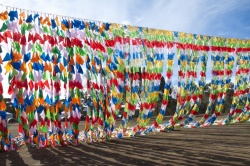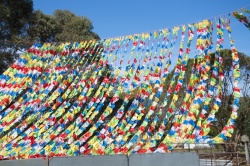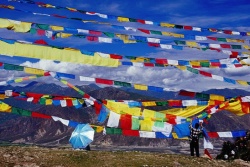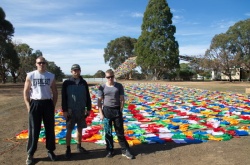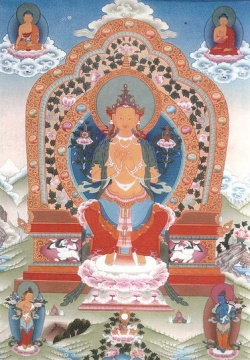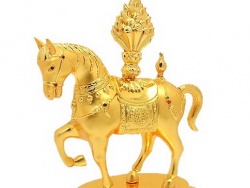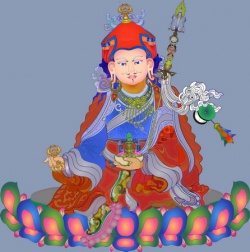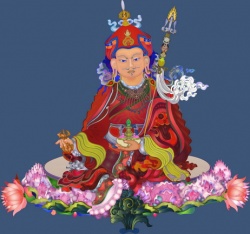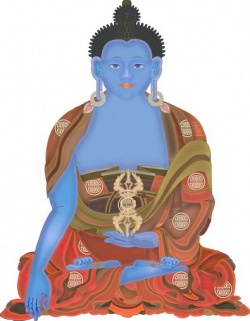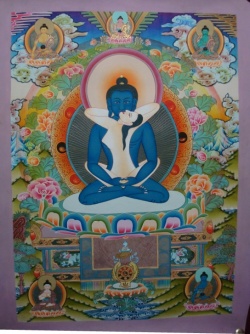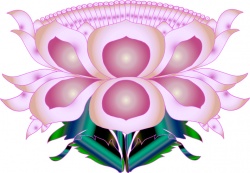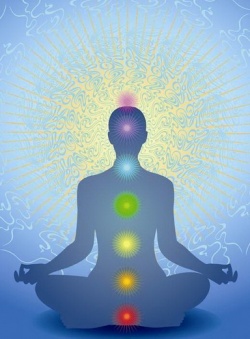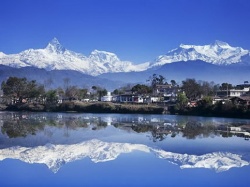A Tibetan prayer flag
Introduction
A Tibetan prayer flag is commonly called lung-ta or "windhorse." That is partly because wherever it appears, the horse stands for amplified energy.
Where it was tamed and especially where used not only as a steed but also as a draft (or, draught) animal, the horse symbolizes force that can be controlled to benefit society. In physics, using the British system, the unit of work is HP, horse-power.
In Buddhism
The horse is one of the 12 animals in the Asian 60-year calendrical cycle. Shakyamuni Buddha is said to have been born in the Year of the Horse, and so 2002, which was mainly a horse year, was considered especially auspicious. The 12
animals rotate through each of the 5 elements and the 2 sexes. (Sadly, a female child born in the Fire Horse year was often put to death because it was believed that she would turn out to be too energetic and hard to manage.)
Compassionate Bodhisattva, Avalokiteshvara (Chenresi) once took the form of a horse. The horse symbolizes energy, and the energetic pursuit of the objectives of Buddha's teachings.
Milarepa used it as a metaphor for Mind in "Song of the Galloping Horse of a Yogi:"
In the mountain hermitage which is my body,
In the temple of my breast
At the summit of the triangle of my heart,
The horse which is my mind flies like the wind.
He gallops on the plains of great bliss.
If he persists, he will attain the rank of a victorious Buddha.
Going backward, he cuts the root of samsara;
Going forward he reaches the high land of buddhahood.
Astride such a horse, one attains the highest illumination.
~translation by Losang P. Lhalungpa. The 100, 000 Songs of Milarepa.
The implication is that the mind is controllable -- it is a steed that can be directed and used in various ways to further our highest aspiration.
The Precious Horse is among the Possessions of a Chakravartin, an Emperor or World Monarch. In the Himalayan Buddhist tradition, these items are represented by symbols that figure as imaginary offerings and figure as
decorations on gifts to spiritual leaders worthy of the highest esteem. Each is associated with a geographic direction, and appropriately (in a Tibetan context,) the horse is related to the southwest.
Chogyur Lingpa (19th century) was the last of the 108 tertons predicted by Padmasambhava. The terton (treasure-revealer or visionary) foresaw that he himself would be reborn as the personal steed of the 18th Karmpapa.
The 16th Karmapa's Horse
"The next time I met the Karmapa was at Surmang monastery, where I had gone to greet my father on his return from Ziling after a long journey. Fortunately, this coincided with the Karmapa's visit to that monastery. In those days, I alternated between being my father's and Samten Gyatso's attendant, depending on which of them was in the Karmapa's entourage.
At Surmang I had a chance to see the Karmapa's horse. This horse was quite unusual, known to give blessings by placing one of its hooves on people's heads. People would stand in line, and as the horse touched their head it made a sound that—with a bit of imagination—sounded like hung hung hung.
Most people got touched very lightly, but once in a while someone got whacked.
I thought to myself, "Who knows what that horse will do to me? Maybe it will split my skull open!" So no one was going to make me get a "blessing." I preferred to stand and watch the others.
Word went around that the Karmapa's horse was giving blessings. There was a long line of people who, each in turn, gave white scarves and offerings of money to the horse. In Khampa style, they would not make such a request empty-handed.
Of course, the horse didn't speak. But it did make a sound each time it touched a person's head, and many people heard the sound as om mani padme hung.
I was waiting for someone to receive one of its "dynamic" blessings, but it didn't happen that day; the horse was quite gentle with everyone.
Many years later, I heard that one day the horse just sat down on its hindquarters and passed away, then continued sitting there. . . . ."
Symbol of the Sun
Surya driving his chariot pulled by seven horses is the subject of many carvings in Hindu temples, and it is well-known that the chariot of the Greek god Apollo in his role as Phoebus (phoibos) mover of the sun, was drawn by a team of horses, too.
There are numerous other deities whose names refer to aspects of light or fire, and several are connected with the horse in some way. Perhaps the flowing manes evoked waving flames; or else, both the sun and the horsemen arose in the east.
The Puranas, source of much of ancient Indian mythology, tell how the solar stallion, Vivasvat, married the daughter of Tvashtar who bore him the twins Yama and Yami. The mother
Saranya could stand his heat no longer and fled having disguised herself as a mare. She left a woman identical to herself in her place, and Vivasvat could not tell the difference. Subsequently the substitute wife gave birth to Manu, the law-giver and ancestor of human beings.
Hence, Yama, Lord of the Dead, and Manu the Law-giver are half-brothers. They were responsible for the first sacrifice.
Vivasvat (also known as Visvakarman) noticed the deception, and taking the form of a horse, he found the mare who subsequently gave birth to the heavenly twins, the Ashvins.
It may be difficult for urban people to see the horse as a solar symbol. However, it is a legend among the Mongols that the heir to the leadership of these tribal people of the steppes was chosen according to which person's mount neighed first at the rising sun.
And, just as in the early part of the 20th century, when "the sun never set on the British Empire," the way a ruler of the horse people could affirm his unchallenged right to rule was to let a sacred white horse loose and claim any territory on which it set foot. This was one version of the aswamedh or horse ritual.
==The Horse Sacrifice==
Another was the Vedic sacrifice of the horse and its offering in a yagna or fire ritual. The flesh of the animal was seen as representing various aspects of the cosmos, as we shall see.
Later, the predominant ruler of northern India performed the other, bloody, kind of horse sacrifice. The main landing on the Ganges at Varanasi is called Dasaswamedh Ghat after the 10,000-animal offering performed there by the King of Benares (Varanasi.)
Much earlier, the Vedic people (known as Aryan after their culture and language, and not their appearance) had a totemic relation with the horse, especially the white stallion. It is recorded that the queen of the people of the horse had to perform a symbolic sexual act with the body of a sacrificed stallion that was believed to endow the earth with fertility and, by association, her husband with the solar essence that imbued him with kingly power.
Harrapan Horseplay: The horse is closely associated with the Aryans who some believe invaded India in the 2nd millennium BCE, but those who hold that the horse culture was an indigenous one attempt to demonstrate that by pointing to representations of the horse on clay seals found in the remains of the ancient Indus Valley cities.
==Buddha's Faithful Steed==
In the account of the life of Buddha Shakyamuni by Ashvaghosha (1st century CE,) the behaviour of the steed, Kamthaka, plays a key role in sensitizing us to the difficulty of life in the animal realm, the role of duty and the nature of karma.
Due to Moghul influence on Indian culture and imagination, people tend to depict his mount as a flowing-maned Arabian type of horse, but the physical characteristics of the animal as described in the epic poem seem typical of an equine breed at least 3,000 years old that is still found today in Turkmenistan.
Originally bred as war mounts, the Akhal-Teke is "the legendary horse from Fergana and Bactria where it was called the Bactrian or Turanian horse and used by the great leaders Darius and Alexander. The cavalry of Darius was mounted on this "horse of quality" and very successful because of it. In Chinese legends it was known as the "heavenly horse" and the "horse that sweats blood." The Chinese attacked Bactria [[[Wikipedia:Afghanistan|Afghanistan]]] in 126 B.C.[E.] solely to obtain some of these . . . ."
". . . a light, elegant build and ... distinctive conformation: long, tapering, aristocratic face; beautifully shaped mobile ears; wide nostrils and large expressive eyes having a proud fiery gaze, The neck is straight, long and often thin, set high on excellent sloping shoulders. Very prominent withers; body long, lean, narrow and sinewy with pronounced croup and sloping hindquarters. Legs long and dry; good forearms and hocks well let down with short cannons of dense bone; the hooves are small with a
thick wall of strong horn. A characteristic feature is the sparse short mane and forelock and absence of feather on the legs. The skin is very thin with a short, fine and silky coat. The overall effect is of the long, lean grace of a greyhound. Magnificent action, free and flowing: in all paces a soft, gliding, elastic stride. Quiet temperament, but easily aroused. Bold, alert and intelligent; responding well to sensitive training. Normal height 15 to 16 hands, weight 900 to 1000 pounds.
". . . blanketing also enhanced the metallic sheen of their coat which is a source of great pride for the owners. The prevailing color is gold; either as golden dun, golden bay or golden chestnut though other colors do occur. This special golden color with a metallic sheen is genetically distinct and is a unique characteristic of the breed." ~ Akhal Teke America web site.
Can there be any doubt this was the Prince's mount? Sadly, there are believed to be only around 3 000 pure-bred Akhlas left in the world.
Cosmic Horse
The fundamental visualization of the pre-Buddhist yogi was the visualization of the sacrifice of the cosmic horse. It was this imaginary act that had as its purpose the empowerment of the ruler as a universal monarch.
The people of ancient India saw the cosmos in the configuration of a horse:
The dawn is the head of the horse and the sun its eye.
<poem>
The wind is its breath and fire is its open mouth.
Its body is the year.
Heaven is its back, and space its belly.
The earth is its under-belly.
The cardinal directions are its flanks and its ribs are the intermediate ones.
Its limbs are the seasons and the months, its joints.
Its hooves are the days and nights.
The stars are its bones, and the clouds, its flesh.
The sand is the food in its stomach and the rivers, its entrails.
The mountains are its liver and lungs, and the herbs and trees, its hair.
The rising sun is its chest, and the setting sun its rump.
The lightning is its yawn, and the thunder, the shivering of its hide.
Rain is its urination, and its voice, its "creative word."
Ma-wang (also, ma huang) is the name of the Celestial Horse in Chinese that is considered the ancestor of all horses. (The name is also used for the plant that yields ephedrine.) Water
In Vedic mythology, it is Varuna, god of heavenly waters, who is equated with the Cosmic Horse, but his mount is the Makara.
Similarly, in Classical mythology Poseidon is said to have created the horse and the Romans referred to the waves of the sea as "Neptune's horses". Multiplicity
The seven days of the week are symbolized by the seven horses drawing the carriage of Hindu solar deity Surya.
Teutonic and Norse mythology describe the steed of Woden/Odin as an eight-legged mare called Sleipnir (cf. to slip).
Sometimes the horse who carried the Prophet of Islam to heaven is similarly described. At other times, he has wings. His name, Barak, means Lightning.
The Book of Revelation (Bible: New Testament) mentions that at the end of time there will appear the Four Horsemen of the Apocalypse: besides a "pale horse, pale rider" whose name is Death, they are War, Pestilence, and Famine.
India, too has an apocalyptic vision: At the end of the last of the Four Ages, the earth will be destroyed by fire and water. Then a new cycle will begin. At the end of this period Vishnu in his tenth avatar as Kalki, will ride into the world on a white horse to save the righteous. In a later version, we see that he becomes the dark horse itself.
The Shambala end-time myth that is associated with the Kalachakra practice mentions many kalkis.
Trojan Horse
The Trojans of The Odyssey & The Iliad and other accounts, who ca. 1450 BCE accepted the hollow form of a horse into their city with so little regard for what it might contain, were neither stupid nor ignorant -- they had already ignored the warnings of two powerful visionaries. However, after 10 years of combat and siege, they could not afford to ignore an offering to the dominant local deities,
for Troy was believed to have been built by Apollo, chariot driver to the Sun, and Poseidon (as associated with the horse as with the ocean.) Also, the Greek hero Herakles had once been promised a gift of horses, which had never been delivered.
Moreover, the site of Troy is not far from the territory of the Hyksos, chariot-driving warriors who marauded down the coast as far south as Egypt, which they conquered. Also, Achilles, the hero of the Achaean Greeks had been educated in his earlier years by Chiron, the centaur (half man and half horse.)
Horses aren't that big? Brooklyn Supreme (1928-1948) was a Belgian grey stallion that stood 19.2 hands (6'6") and weighed almost 3,200 pounds.
Epona was a female horse deity of ancient Britain adopted by the Romans. Veronica Doubleday's excellent site depicts a few ancient representations of Epona, and also the graceful Uffington Horse. That stylized chalk line drawing measuring 374 feet (114 meters) was recently dated to 3,000 BP [before the present.] It is only 1 of six equine figures in the region.
See the various breeds of the world's horses.
Takhi, the Mongolian species, known to zoologists as Przewalski's horse, preserves the equine's oldest qualities. In 1945, only 12 remained alive. Now there are 1200 in various zoos but sadly, none in their natural habitat.
Ass and Mule
By the way, not all equines that are depicted in tangkas are horses. For example, the steed of protector Palden Lhamo is said to be a wild ass (kiang) or a mule, the sturdy pack or draft animal produced by breeding a mare with a donkey.
The "Rann of Kutch" in Gujarat, Northern India, is home to the last remaining population of Asiatic wild ass.
___________________________________________________________
lung: The Tibetan word lung is a homonym that not only stands for the movement of the upper air, but for the "wind" or prana (Skt.) that courses through the channels of the subtle body. It is also used for the oral transmission of a tantric practice by a lama.
partly: The other reason is that there is a tradition that it was a horse laden with Buddhist scriptures that brought the dharma to China. The Chinese depict a mythological creature in this role rather than a horse.
Vishvakarman: Vivasvat is also known as Vishvakarman, the divine architect whose role it was to fulfill the compulsive construction aspirations of Lord Indra. He finally did so by teaching the King of Gods the great lesson of Impermanence: He showed him the procession of ants -- each one an Indra, and each one limited by Time! </poem>
